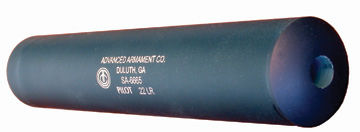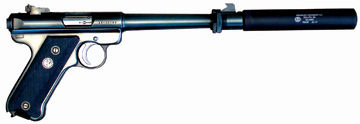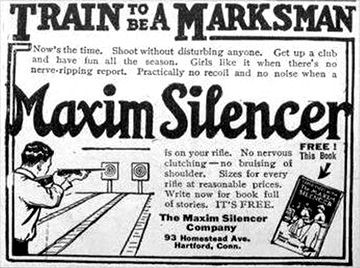*Offer expires 04/30/24 at 3 a.m. ET. Some exclusions apply.
*Offer expires 04/30/24 at 3 a.m. ET. Some exclusions apply.
by Tom Gaylord
exclusively for PyramydAir.com. Copyright 2006 All Rights Reserved
In this article, I'll discuss some of the most important points about silencers. The purpose of this report is to give you the information you need to make an informed decision.
The subject of airgun silencers is hotly debated on the airgun forums. There is no agreement about the legality of silencers on airguns in the U.S., and the issue is far more complex than it seems at first.
This is the definition of a silencer contained in U.S. Code, Title 18, Part 1, Chapter 44, Subsection 922:
(24) The terms "Firearm Silencer" and "Firearm Muffler" mean any device for silencing, muffling, or diminishing the report of a portable firearm, including any combination of parts, designed or redesigned, and intended for use in assembling or fabricating a firearm silencer or firearm muffler, and any part intended only for use in such assembly or fabrication.
Further wording in the Code defines the silencer to be a firearm that must be serial-numbered and controlled. The use of a silencer in a crime can add penalties to the punishment for that crime, and the possession of an unregistered or unserial-numbered (i.e., homemade) silencer are both crimes by themselves.
The law
As an American citizen, you may request permission from the federal government to own a silencer. Unlike the right to own firearms, however, owning a silencer is not a right guaranteed under the Constitution. The various states and local municipalities can refuse to agree to your application, leaving you with no recourse. My research at the time I wrote this article turned up the following 36 states that permit the private ownership of silencers: AL, AR, AK, AZ, CO, CT, FL, GA, ID, IN, KY, LA, ME, MD, MS, MT, NE, NV, NH, NM, NC, ND, OH, OK, OR, PA, SC, SD, TN, TX, UT, VA, WA, WV, WI and WY. However, just because the STATE allows ownership is no guarantee that the local authorities will agree.
You apply for permission to purchase and own a silencer on ATF Form 4. This is submitted to the National Firearms Act branch of BATF in duplicate, along with two sets of fingerprints from your local police station, two passport photos and a check for $200. Your local chief of police or equivalent law enforcement official is requested to answer two questions on Form 4. If he objects, he does not have to answer the questions and you don't get the silencer - that simple. If there is an appeal process, I was unable to find it.
If you are fortunate enough to get a silencer purchase approved, as I was, then that silencer is yours to use legally for the rest of your life.


SO WHAT? We're talking about airguns here!
Yes we are, and most airgunners know that the Bureau of Alcohol, Tobacco, Firearms and Explosives (BATFE) has jurisdiction over firearms ONLY. In fact, U.S. Code specifically prohibits any federal, state or local municipality from declaring an airgun to be a firearm. Not only do the federal firearms laws NOT apply to airguns, they CANNOT be applied by law! But that doesn't get us out of the woods.
However...
IF you have an airgun silencer, and IF it can be removed and installed on a firearm, and IF it then quiets that firearm - that silencer meets the legal definition and is subject to the law. However, in the United States, a person is considered innocent until proven guilty, so it is also necessary to prove intent, as in you intended to use the silencer in your possession on a firearm. Therein lies the problem.
At this point, I will cut directly to the chase. When you are tried for owning an illegal silencer, the federal government will vigorously prosecute their case against you. A court case uses a lot of resources, and they don't like to lose. The decision usually comes down to the judge after both sides have presented their case. You probably know that there are some judges who see their duty as interpreting the law, and there are other activist judges who see their duty as rectifying the current social situation - "putting things right," as it were. If you happen to draw the latter kind of judge, the outcome could be devastating. Even if you do happen to win, the time, money and heartache of preparing for a trial isn't pleasant for most people.

When it comes to the question of airgun silencers, I have a saying I live by, "I don't want to learn the law while sitting at the defendant's table." Now, I happen to own a legal silencer, and whatever I do with it is my business as long as I obey the law. So, I can put my silencer on a loud airgun to make it quiet, if I want to. I can also sleep at night.
What about a moderator?
Shakespeare said it best, "A rose, by any other name, would smell as sweet." Calling a silencer a moderator doesn't change the law. Better read that definition again.
I think some people are confused about the difference between a moderator and a compensator. Moderator is the European term for silencer. A compensator is a device that also fits on the end of a barrel to do one or two things. One - it directs gasses away from the tail of a bullet or pellet, reducing any disturbance to its ballistic flight. Two - it directs gasses upward to counteract the tendency for the muzzle to flip up as the bullet leaves. A compensator exists to improve accuracy, while a moderator/silencer/suppressor/sound attenuation device (or any other name you can think of) is designed to quiet the report of a firearm.
What about a silencer that's permanently attached to the airgun? That's okay, as long as it can't be removed with a carbide cutoff wheel, a hacksaw or an oxy-acetylene torch.
REALLY?
The truth is I don't know and neither does anyone else. I merely point out the absurdity of thinking that something can be permanent.
What about a shrouded barrel?
AirForce Airguns was the first to market the shrouded barrel with their popular Talon SS. The short SS barrel is housed inside the gun's longer frame, and an end cap strips away the loud noise of the shot as the pellet passes through. It clearly isn't a silencer because there is no device involved. However - a number of johnny-come-latelys are now marketing aftermarket barrel shrouds for guns that didn't have them originally. Could any of these "devices," for that is what they are, be attached to a firearm and diminish the report? I don't know and, as I said before, I don't intend finding out the hard way.
Don't there have to be baffles inside for a device to be considered a silencer?
No more than an airgun has to operate on air (i.e., CO2 guns). Baffles were in one of the very first firearm silencers patented by Hiram Maxim in 1909, but there is no mention of baffles in the legal definition. The reason everyone talks about baffles is because they are still an effective way to silence a firearm's report. But baffles are not required.

So, what is a muzzlebrake?
In the United States, a muzzlebrake is a swelling at the muzzle of an airgun. On breakbarrels, it often gives more leverage for cocking. On other types of airguns, it's decorative. On a .50 BMG, it's a type of compensator that helps reduce felt recoil. In the United Kingdom, it's a slang term for moderator, which is their term for a silencer.
Yeah, but will the government really prosecute?
You can play Russian roulette with your life if you want to, but leave me out of it. Yes, the government will prosecute. I know airgunners who have been arrested and had their silencers confiscated. If the government can make a case, have no doubt that they will. I know dealers who have been "visited" by representatives of BATFE because they were selling airgun silencers. You can joke about this with your buddies, but when you are seated facing two or three government agents and forced to have a long, in-depth conversation on a subject you know only a little about, things come into sharp focus.
What about airguns that have real silencers built in from the factory?
1. The TX200 Mk III has a shrouded barrel with baffles in the end of it. It is clearly a pellet gun silencer. HOWEVER, it doesn't do that much for the TX200, because that airgun isn't loud to begin with, and if someone were to go to the trouble of cutting the shroud and baffles off a TX200 and mounting it on a firearm, they would be insane. Why spend over $500 to get materials you can buy at Home Depot for under $5? Why do WORK to get them, instead of just buying them as pieces? And, why work EVEN HARDER to lash them to a firearm, where they would be hopelessly inefficient because of how they were made and what they were originally designed to do? If the government hates you that much (to prosecute such an unworthy case), they can just hire a hit man and be done with it for far less time and effort.
So, the TX200 with built-in silencer is okay!
2. George Bigbore handmakes a .25 caliber air rifle that develops 120 foot-pounds of energy - the equivalent of a .22 Long Rifle cartridge. George is a rugged individualist who talks louder when he's disagreed with. He likes "living off the grid," though he would be surprised to learn that his lifestyle attracts even more attention and has generated a thick FBI file. George makes and sells a dozen air rifles each year. Some of them have parts that could be removed and put on a firearm to diminish its report. BATFE agents have started their own file on George, but he is such a minnow that they don't even toss him into the pan when frying a bigger fish. Time is on their side, though, and one day old George may cross the line far enough that the government decides to send a message to the other 437 known makers of "fringe" silencers. With their thick file, plus whatever George just did to put himself over the top, it's showtime!
Your custom high-power super-silent .25 caliber air rifle made by George Bigbore may have an unregistered silencer on it. If George goes down, he may take you with him. Then you can listen to him complain loudly for hours that the government had it in for him, as you both mop the floors of cellblock B.
Why doesn't somebody write to the head of BATFE and request that they make a ruling about airgun silencers?
It's been done - MANY times. The BATFE has no more authority over airguns than the government of Australia has over the United States. Airguns are outside the scope of the Bureau's charter, so they cannot issue any kind of statement about them. Silencers, on the other hand, are their bread and butter. So, if a device can be REMOVED from an airgun and ATTACHED to a portable firearm and diminish its report, that device is then legally defined as a silencer. If that silencer has no serial number, it becomes a firearm without a serial number - the possession of which is a criminal offense. If you made it, you could be found guilty of manufacturing a firearm without a license - another criminal offense. If the judge decides that your legal ownership of a .22 rimfire rifle constitutes the intent to attach your illegal silencer to a firearm, you could lose everything you own and go to prison.
I can't sum this up any better than to say I've been summing it up all along. The airgun silencer issue is complex, convoluted and anything but clear. If someone tries to convince you otherwise, don't listen to another word they say.
My thanks to Bob the Gunman for the use of his graphics with this article.
Buy With Confidence
Get FREE shipping on qualifying orders! Any order $150+ with a shipping address in the contiguous US will receive the option for free ground shipping on items sold & shipped by Pyramyd AIR during checkout. Certain restrictions apply.
Free shipping may not be combined with a coupon unless stated otherwise.
View Shipping Info
We work hard to get all orders placed by 12 pm EST out the door within 24 hours on weekdays
because we know how excited you are to receive your order.
Weekends and holiday shipping times will vary.
During busy holidays, we step our efforts to ship all orders as fast as possible,
but you may experience an additional 1-2 day delay before your order ships.
This may also happen if you change your order during processing.
View Shipping Times
It's important to know that due to state and local laws, there are certain restrictions for various products.
It's up to you to research and comply with the laws in your state, county, and city.
If you live in a state or city where air guns are treated as firearms you may be able to take advantage of our FFL special program.
U.S. federal law requires that all airsoft guns are sold with a 1/4-inch blaze orange muzzle
or an orange flash hider to avoid the guns being mistaken for firearms.
View Shipping Restrictions
Get the most out of your equipment when you work with the expert technicians at Pyramyd AIR. With over 25 years of combined experience, we offer a range of comprehensive in-house services tailored to kickstart your next adventure.
If you're picking up a new air gun, our team can test and tune the equipment before it leaves the warehouse. We can even set up an optic or other equipment so you can get out shooting without the hassle. For bowhunters, our certified master bow technicians provide services such as assembly, optics zeroing, and full equipment setup, which can maximize the potential of your purchase.
By leveraging our expertise and precision, we ensure that your equipment is finely tuned to meet your specific needs and get you ready for your outdoor pursuits. So look out for our services when shopping for something new, and let our experts help you get the most from your outdoor adventures.
View Service Info
Shop and purchase with confidence knowing that all of our air guns (except airsoft) are protected
by a minimum 1-year manufacturer's warranty from the date of purchase unless otherwise noted on the product page.
A warranty is provided by each manufacturer to ensure that your product is free of defect in both materials and workmanship.
View Warranty Details
Didn't get what you wanted or have a problem? We understand that sometimes things aren't right and our team is serious about resolving these issues quickly. We can often help you fix small to medium issues over the phone or email.
If you need to return an item please read our return policy.
Learn About Returns
Get FREE shipping on qualifying orders! Any order $150+ with a shipping address in the contiguous US will receive the option for free ground shipping on items sold & shipped by Pyramyd AIR during checkout. Certain restrictions apply.
Free shipping may not be combined with a coupon unless stated otherwise.
View Shipping Info
Want More?
Join Our Email List for News and Deals!
Join the Pyramyd AIR mailing list: Our e-mails are filled with new products, deals, sneak peeks, tips and tricks, contests and more - sign up today!
Text JOIN to 91256 and get $10 OFF Your Next $50+ Order!
* By providing your number above, you agree to receive recurring autodialed marketing text msgs (e.g. cart reminders) to the mobile number used at opt-in from Pyramyd AIR on 91256. Reply with birthday MM/DD/YYYY to verify legal age of 18+ in order to receive texts. Consent is not a condition of purchase. Msg frequency may vary. Msg & data rates may apply. Reply HELP for help and STOP to cancel. See Terms and Conditions & Privacy Policy.